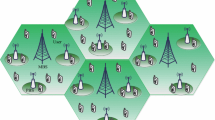Abstract
We propose a distributed channel allocation algorithm based on a threshold scheme, called D-CAT, for cellular mobile networks. The algorithm employs two thresholds: (i) a heavy threshold for determining whether a cell is heavy, or overloaded, and for triggering the channel allocation algorithm; and (ii) a target threshold for indicating the target number of free channels that a heavy cell intends to acquire. Based on the two-threshold scheme, the D-CAT algorithm can determine the optimal number of free channels as well as the cell(s) from where a heavy cell should import channels in order to satisfy the required channel demand. Simulation experiments and analyses show that the proposed algorithm incurs lower overhead for channel allocation and is more efficient in terms of channel utilization than other distributed channel allocation algorithms. It also outperforms other centralized and distributed algorithms in terms of call blocking probability.
Similar content being viewed by others
References
A. Baiocchi, F.D. Priscoli, F. Grilli and F. Sestini, The geometric dynamic channel allocation as a practical strategy in mobile networks with bursty user mobility, IEEE Trans. Vehicular Tech. 44(1) (1995) 14–23.
U. Black, Mobile and Wireless Networks (Prentice Hall PTR, 1996).
G. Cao and M. Singhal, Efficient distributed channel allocation for mobile cellular networks, in: Proc. IEEE 7th Internat. Conf. Comput. and Commun. Networks (October 1998) pp. 50–57.
G. Cao and M. Singhal, An adaptive distributed channel allocation strategy for mobile cellular networks, in: Proc. 18th IEEE Internat. Conf. Performance, Computing and Commun. (February 1999) pp. 36–42.
G. Cao and M. Singhal, Distributed fault-tolerant channel allocation for mobile cellular networks, in: Proc. IEEE INFOCOM'99 (March 1999) pp. 584–591.
G. Cao and M. Singhal, An adaptive distributed channel allocation strategy for mobile cellular networks, Distrib. Comput. 60(4) (2000) 451–473.
D.C. Cox and D.O. Reudink, Increasing channel occupancy in large scale mobile radio systems: Dynamic channel reassignment, IEEE Trans. Vehicular Tech. VT-22(4) (1973) 218–222.
S.K. Das, S.K. Sen and R. Jayaram, A dynamic load balancing strategy for channel assignment using selective borrowing in cellular mobile environment, Wireless Networks 3(5) (1997) 333–348.
S.K. Das, S.K. Sen and R. Jayaram, A noval load balancing scheme for the tele-traffic hot spot problem in cellular networks, Wireless Networks 4(4) (1998) 325–340.
S.K. Das, S.K. Sen and R. Jayaram, D-LBSB: A distributed load balancing algorithm for channel assignment in cellular mobile networks, J. Interconnection Networks 1(3) (2000) 195–220.
X. Dong and T.H. Lai, Distributed dynamic carrier allocation in mobile cellular networks: Search vs. Update, in: Proc. IEEE 17th Internat. Conf. Dist. Comput. Syst. (1997) pp. 108–115.
N. Garg, M. Papatriantafilou and P. Tsigas, Distributed list coloring: How to dynamically allocate frequencies to mobile base stations, in: Proc. 8th Annual IEEE Sympos. Parallel and Dist. Process. (October 1996) pp. 18–25.
V.K. Garg, K.F. Smolik and J.E. Wilkes, Applications of CDMA in Wireless/Personal Communications (Prentice Hall PTR, NJ, 1997).
J.D. Gibson (ed.), Mobile Communications Handbook (CRC Press, 1999).
H. Jiang and S.S. Rappaport, CBWL: A new channel assignment and sharing method for cellular communication systems, IEEE Trans. Vehicular Tech. 43(2) (1994) 313–322.
L. Lamport, Time, clocks, and the ordering of events in a distributed system, Commun. ACM 21(7) (1978) 558–565.
R. Prakash, N. Shivaratri and M. Singhal, Distributed dynamic channel allocation for mobile computing, in: Proc. 14th ACM Sympos. Principles of Distributed Computing (1995) pp. 47–56.
T.S. Rappaport, Wireless Communications — Principles and Practice (Prentice Hall, NJ, 1996).
G.L. Stuber, Principles of Mobile Communication (Kluwer Academic, Boston, MA, 1996).
J. Tajima and K. Imamura, A strategy for flexible channel assignment in mobile communication systems, IEEE Trans. Vehicular Tech. 37(2) (1988) 92–103.
S. Tekinay and B. Jabbari, Handover and channel assignment in mobile cellular networks, IEEE Commun. Magazine 29(11) (November 1991) 42–46.
M. Zhang and T.S.P. Yum, Comparisons of channel-assignment strategies in cellular mobile telephone systems, IEEE Trans. Vehicular Tech. 38(4) (1989) 211–215.
Y. Zhang and S.K. Das, An efficient load-balancing algorithm based on a two-threshold cell selection scheme in mobile cellular networks, Comput. Commun. 23(5–6) (2000) 452–461.
Author information
Authors and Affiliations
Rights and permissions
About this article
Cite this article
Zhang, Y., Das, S.K. & Jia, X. D-CAT: An Efficient Algorithm for Distributed Channel Allocation in Cellular Mobile Networks. Mobile Networks and Applications 9, 279–288 (2004). https://doi.org/10.1023/B:MONE.0000031587.24067.fa
Issue Date:
DOI: https://doi.org/10.1023/B:MONE.0000031587.24067.fa




